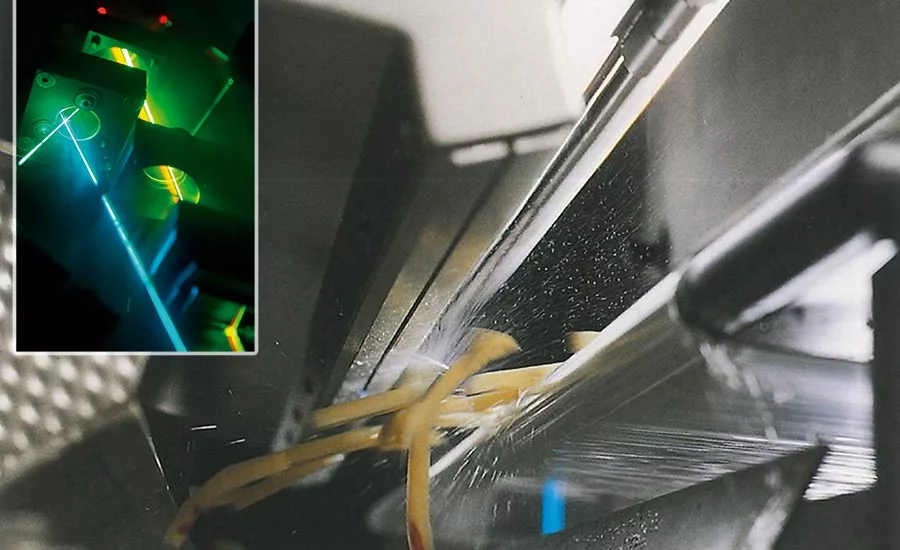Engineering R&D
Laser scanning and photonics help identify acrylamide in potato products
Newly developed real-time photonics/laser scanning technology detects precursors to acrylamide in raw French fries and potato chips prior to cooking.


The laser sorting machine scans for cut potatoes with acrylamide precursors, rejecting those toward the bottom. Inset shows a close-up of the laser’s illumination path. Source: Tomra Sorting Solutions NV.
While FDA issued a final guidance in 2016 detailing how processors and foodservice operators can reduce acrylamide in cooked and fried foods such as potatoes, it made no suggestions for screening out raw product with acrylamide precursors before the cooking process. Earlier this year, Britain’s Food Standards Agency issued warnings about eating burnt toast and over-fried potato products that may contain carcinogens such as acrylamide. Trouble is: Not all potatoes produce high levels of acrylamide in frying—and there hasn’t been a method to test raw potatoes in real time as they travel down the conveyor to the fryer.
That, however, has changed. Dr. Lien Smeesters, a post-doctoral researcher at the University of Brussels on the B-PHOT Brussels Photonics Team and the recent winner of the Student Innovation Award at the Photonics Public Private Partnership Annual Meeting, focused laser-based photonics technology on the problem and has come up with a solution. In collaboration with Tomra Sorting Solutions, Smeesters has developed a new sensor that scans peeled potatoes, sorting out products that may cause high levels of the toxic acrylamide before the cooking process begins.
Tomra Sorting Solutions has filed for a new patent on the technology, which the company will integrate into one of its inline sorting machines. FE caught up with Smeesters to get some more details.
FE: How long has this technology been in development?
Dr. Lien Smeesters: The investigation of acrylamide monitoring using optical spectroscopy was one of the main focus points of my PhD research. This research was executed in the framework of an IWT project (funded by the Flemish government and now called VLAIO) that ran from 2012 up to 2016, in collaboration with Tomra Sorting Solutions NV.
FE: Why has acrylamide detection been so difficult? Can a visual inspection of a raw potato determine if that potato will produce high levels of acrylamide in frying?
Smeesters: The raw potatoes giving rise to low or high acrylamide content during frying cannot be visually distinguished. In addition, the commonly used potato quality tests, like underwater-weight tests, are not able to predict the acrylamide formation during frying. Therefore, the development of a novel, non-destructive, accurate detection technology enabling the identification of potatoes unsuited for frying is of indispensable value.
FE: Why use photonics to determine potato composition instead of the more traditional chemical analysis?
Smeesters: In contrast to sample-based potato quality evaluation tests and chemical analysis, optical technologies offer a non-destructive alternative, enabling the screening of all individual food products, since the lasers do not affect the quality of the products.
FE: How does the laser scanning technology work? What does it “see” that will cause acrylamide in frying? What are the acrylamide precursors?
Smeesters: Acrylamide precursors are the substituents in the raw potato influencing the acrylamide formation during frying, including water, starch and reducing sugars.
The laser scanning device uses optical spectroscopy to study the composition of the raw potatoes to monitor the acrylamide precursors. Optical spectroscopy studies the interaction of light with matter. More specifically, it studies which part of the incident light will be transmitted, reflected or absorbed by the product. This interaction of the incident light is dependent on the chemical structure of the products, thus giving information about their composition.
FE: How does your laser technology work in conjunction with Tomra’s sorting machines?
Smeesters: Tomra’s laser-based optical sorting machines are scanning devices in which the food products can be screened by lasers at high speed. Multiple lasers illuminate the products, after which the reflected and scattered light signals are interpreted, and the unwanted products can be removed from the food stream. During my research, I studied the integration of my specialized optical detection criterion for the sensing of acrylamide precursors into these inline scanning/sorting machines.
FE: What can be done with the potatoes that fail the test? Can they be repurposed?
Smeesters: The unsuited potatoes are certainly not lost. Potatoes only form acrylamide at high temperatures, exceeding 120°C (248°F). Consequently, the potatoes that are unsuited for frying can still be used for low-temperature processing, like mashed potatoes or potato soup.
FE: Potato chips (crisps) are often checked in a visual inspection machine for color after frying. This test alone isn’t sufficient for spotting high levels of acrylamide, is it?
Smeesters: Acrylamide is formed during high-temperature processing of potatoes, as a side-product of the Maillard reaction. This reaction is also responsible for the taste, structure and browning of the French fries. The darker the coloration of the French fries, the higher the acrylamide concentration that is formed. However, defining an accurate threshold on (the) basis of color is difficult, since two French fries that appear equally brown can still show different acrylamide contents. To ensure food safety, a more accurate inspection is indispensable. In addition, the screening after frying induces large economical losses, since unsuited French fries cannot be consumed and need to be removed from the food chain. Consequently, a precursor screening instead of the after-processing detection also minimizes food waste.
FE: Could your test be adapted to test for acrylamide in other food applications? If so, what?
Smeesters: We focused on the acrylamide formation during the frying of potatoes, since potatoes are cultivated in approximately 80 percent of all countries, and extremely high acrylamide concentrations (up to 20 times higher than the European recommendations) have been quantified in French fries. The extensibility of our optical acrylamide precursors detection methodology to other products still needs to be validated. However, promising results are expected, e.g., for the acrylamide monitoring during the production process of crisps.
FE: When and where will the equipment be available? Have you worked with any food companies to date?
Smeesters: Our research was performed in collaboration with Tomra Sorting Solutions. Within our research, we focused on the fundamental optical study of the acrylamide precursors, the development of a detection criterion and its demonstration in a laser-based scanning configuration. Tomra Sorting Solutions filed a patent describing this technology and will integrate the technology into their laser-based sorting machines. Currently, validation tests of the technology are ongoing.
FE: What do you see as the technology’s future? Can it be adapted for foodservice or home usage?
Smeesters: The possible future developments based on this technology can indeed result in a home-use potato quality evaluation scanner. The miniaturization of the developed technology can result in a handheld device, enabling one to perform the potato quality test at home. In this case, the consumer would be able to scan potatoes to evaluate the risk on high acrylamide formation during frying.
Looking for a reprint of this article?
From high-res PDFs to custom plaques, order your copy today!








